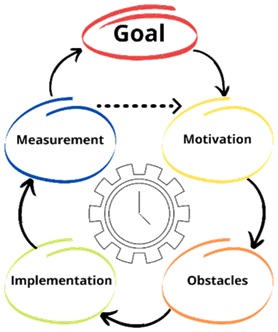A Coaching Model Created by Rudy Shukri
(Performance Improvement Coach, CANADA)
Introduction:
My coaching model is based on the infamous SMART methodology of setting objectives. However, it does not focus only on the “what to do”, but also on the journey: the “How to do it”, and the “Why to do it”.
Throughout this journey, the coach brings in curiosity, rapport, open-mindedness, and, last but not least, empathy.
The coach helps the clients start with the end in mind by discovering their big goal, articulating the motivators and obstacles, designing the implementation plans, measuring the results, and finally reflecting on the outcomes.
Just like life, this journey is a cycle, every step has a goal, and every goal is unique.
Goal:
People with goals succeed because they know where they are going. Earl Nightingale
A great quote by Mr. Nightingale, however, what seems to be a clear goal could sometimes be just a stepping stone to another goal.
The coaching journey begins with the intent to know more, build rapport, and create a safe environment for the clients.
With curiosity and openness, the coach helps the clients peel the onion to reach the core, the vision, the goal.
To reach the goal, we need to know where we stand. With complete openness and transparency in mind, the clients are assisted by the coach to assess the current situation and share where they really stand.
Motivation:
All of our dreams can come true if we have the courage to pursue them. Walt Disney
In a few words, this step is to articulate the “Why” and “Why Now”.
The coach helps the clients find what motivates them, what fuels their drive towards their steps and goals, and what gives them the courage to be the best.
Obstacles:
An obstacle is often a stepping stone. Prescott Bush
Our lives are mixed with ups and downs, successes and failures driven by internal and external forces that continuously push and pull.
In this step, the coach shines a brighter light on those obstacles and helps the clients dissect them, understand them, face them, eliminate/modify/overcome them, learn from them, and finally, make them steppingstones.
Implementation:
It’s not the ideas; it’s design, implementation, and hard work that make the difference. Michael Abrash
We have a big goal, we have what fuels courage, we can see the obstacles as steppingstones, now is the time to break the goal down into smaller SMART goals.
The coach uses this step to help the clients define the path needed by starting with the big goal, figuring out what is needed to reach that step, and working backward until the current situation is reached.
Each step becomes a goal by itself and, by using the SMART methodology, clients would have a crystal-clear path that is Specific, Measurable, Attainable, Realistic, and Time-bound.
After the implementation of the first goal, a measure of the outcomes is due.
Measurement:
Measurement is the first step that leads to control and eventually to improvement. If you can’t measure something, you can’t understand it. If you can’t understand it, you can’t control it. If you can’t control it, you can’t improve it. James Harrington
Gaining control of your path can only happen with measurement. Whether it was a positive or a negative outcome, reflecting on the results will bring lifelong lessons. With learned lessons comes progress!
In this step, the coach supports the clients to verbalize the lessons learned and how those lessons would be used in the future.
The process repeats for the subsequent steps or goals until the big goal is reached.
The end
